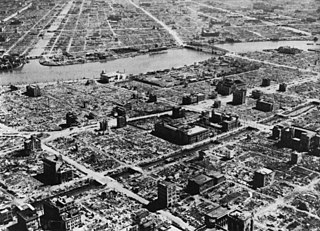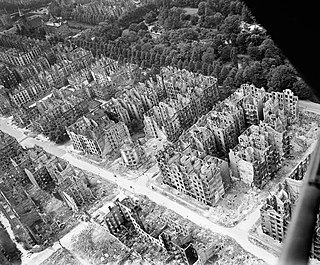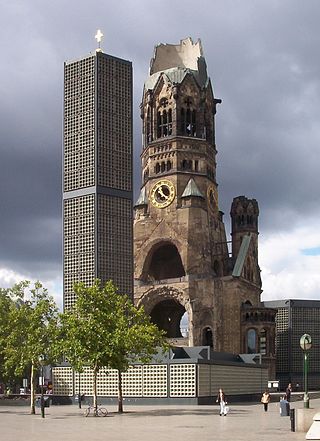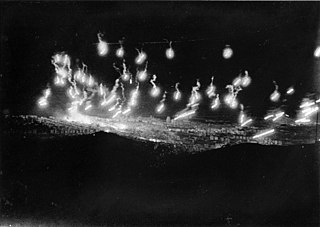
Strategic bombing is a systematically organized and executed attack from the air which can utilize strategic bombers, long- or medium-range missiles, or nuclear-armed fighter-bomber aircraft to attack targets deemed vital to the enemy's war-making capability. It is a military strategy used in total war with the goal of defeating the enemy by destroying its morale, its economic ability to produce and transport materiel to the theatres of military operations, or both. The term terror bombing is used to describe the strategic bombing of civilian targets without military value, in the hope of damaging an enemy's morale.

The bombing of Dresden was a joint British and American aerial bombing attack on the city of Dresden, the capital of the German state of Saxony, during World War II. In four raids between 13 and 15 February 1945, 772 heavy bombers of the Royal Air Force (RAF) and 527 of the United States Army Air Forces (USAAF) dropped more than 3,900 tons of high-explosive bombs and incendiary devices on the city. The bombing and the resulting firestorm destroyed more than 1,600 acres (6.5 km2) of the city centre. Up to 25,000 people were killed. Three more USAAF air raids followed, two occurring on 2 March aimed at the city's railway marshalling yard and one smaller raid on 17 April aimed at industrial areas.

The Blitz was a German bombing campaign against the United Kingdom, in 1940 and 1941, during the Second World War. The term was first used by the British press and originated from the term Blitzkrieg, the German word meaning 'lightning war'.

The Allied bombing of Hamburg during World War II included numerous attacks on civilians and civic infrastructure. As a large city and industrial centre, Hamburg's shipyards, U-boat pens, and the Hamburg-Harburg area oil refineries were attacked throughout the war.

World War II (1939–1945) involved sustained strategic bombing of railways, harbours, cities, workers' and civilian housing, and industrial districts in enemy territory. Strategic bombing as a military strategy is distinct both from close air support of ground forces and from tactical air power. During World War II, many military strategists of air power believed that air forces could win major victories by attacking industrial and political infrastructure, rather than purely military targets. Strategic bombing often involved bombing areas inhabited by civilians, and some campaigns were deliberately designed to target civilian populations in order to terrorize them and disrupt their usual activities. International law at the outset of World War II did not specifically forbid the aerial bombardment of cities – despite the prior occurrence of such bombing during World War I (1914–1918), the Spanish Civil War (1936–1939), and the Second Sino-Japanese War (1937–1945).

Berlin, the capital of Nazi Germany, was subject to 363 air raids during the Second World War. It was bombed by the RAF Bomber Command between 1940 and 1945, the United States Army Air Forces' Eighth Air Force between 1943 and 1945, and the French Air Force in 1940 and between 1944 and 1945 as part of the Allied campaign of strategic bombing of Germany. It was also attacked by aircraft of the Red Air Force in 1941 and particularly in 1945, as Soviet forces closed on the city. British bombers dropped 45,517 tons of bombs, while American aircraft dropped 22,090.3 tons. As the bombings continued, more and more people fled the city. By May 1945, 1.7 million people had fled.
Big Week or Operation Argument was a sequence of raids by the United States Army Air Forces and RAF Bomber Command from 20 to 25 February 1944, as part of the Combined Bomber Offensive against Nazi Germany. The planners intended to attack the German aircraft industry to lure the Luftwaffe into a decisive battle where the Luftwaffe could be damaged so badly that the Allies would achieve air superiority and would ensure success of the Normandy landings later in 1944.

Prague, the capital and largest city of the German-occupied Protectorate of Bohemia and Moravia, was bombed several times by the Allies during World War II. The first Allied aircraft to fly over Prague was a single bomber of the French Air Force in April 1940, but it dropped propaganda leaflets, not bombs. The first bombing mission was flown by the Royal Air Force (RAF) in October 1941. Prague was then bombed three times by the United States Army Air Forces between the fall of 1944 and spring of 1945. During the Prague uprising of 5–9 May 1945, the Luftwaffe made use of bombers against the rebels.

The bombing of Osaka during World War II was part of the strategic bombing campaign waged by the United States against military and civilian targets and population centers in Japan. It first took place from the middle of the night on March 13, 1945, to the early morning of the next day. There were also bomb raids on June 1, 6, 7, 15, 26, July 10, 24, and August 14, the last day of the war. It is said that more than 10,000 civilians died in these bombings in Osaka, Japan.

During World War II, Allied forces conducted air raids on Japan from 1942 to 1945, causing extensive destruction to the country's cities and killing between 241,000 and 900,000 people. During the first years of the Pacific War these attacks were limited to the Doolittle Raid in April 1942 and small-scale raids on military positions in the Kuril Islands from mid-1943. Strategic bombing raids began in June 1944 and continued until the end of the war in August 1945. Allied naval and land-based tactical air units also attacked Japan during 1945.

Gorla is a district ("quartiere") of Milan, Italy. It is part of the Zone 2 administrative division, located north-east of the city centre. Before 1923, Gorla was an independent comune. The name "Gorla" is probably derived from the latin word gulula, meaning "little cleft".

Haddock Force was the name given to a number of Royal Air Force bombers dispatched to airfields in southern France to bomb northern Italian industrial targets, once Italy declared war, which was thought to be imminent. Italy entered the Second World War on 10 June 1940 and the plan was put into effect but at first, the local French authorities prevented the RAF Vickers Wellington bombers from taking off. Armstrong Whitworth Whitleys flying from England via the Channel Islands made the first raid on the night of 11/12 June 1940.

As the main economic and industrial center in Italy, and the country's second largest city, Milan was subjected to heavy bombing during World War II, being the most bombed city in Northern Italy and one of the most bombed cities in the country.

The bombing of Obersalzberg was an air raid carried out by the Royal Air Force's Bomber Command on 25 April 1945 during the last days of World War II in Europe. The operation targeted Obersalzberg, a complex of residences and bunkers in Bavaria which had been built for Adolf Hitler and other key members of Germany's leadership. Many buildings in the complex were destroyed, though Hitler's residence and the bunker network were only slightly damaged. Two Allied bombers were shot down with the loss of four airmen, and 31 Germans were killed.

The bombing of Cagliari was a series of attacks by the United States Army Air Force and the Royal Air Force on the Italian city of Cagliari, the regional capital of Sardinia, during World War II. The raids, aimed at destroying the port facilities and airfields of Cagliari, also resulted in the destruction of most of the city.

Owing to its importance as an industrial center, home to Fiat and several other industries engaged in war production, Turin, the regional capital of Piedmont, suffered over a hundred raids by the Allied air forces during World War II; the Piedmontese capital was thus among the most bombed cities in Northern Italy, suffering damage to about 40% of its housing stock, and over 2,000 victims among its population.

During World War II the Italian city of Palermo, the regional capital and largest city of Sicily, was heavily bombed by both the Royal Air Force and the United States Army Air Force.

During World War II, Tuscany, the Italian port city of Livorno was repeatedly bombed by the Allied air forces, suffering about a hundred raids altogether, which resulted in it being among the most war-damaged cities in Italy.

Owing to the importance of its port and industries, the Italian port city of Genoa, the regional capital and largest city of Liguria, was heavily bombarded by both Allied air and naval forces during Second World War, suffering heavy damage.

The bombing of Reggio Calabria was a series of attacks by the United States Army Air Force and the Royal Air Force on the Italian city of Reggio Calabria during World War II. All together, Reggio Calabria suffered 24 air raids, aimed at disabling its port facilities, airfield and marshalling yards, leaving most of the city destroyed or damaged.



















